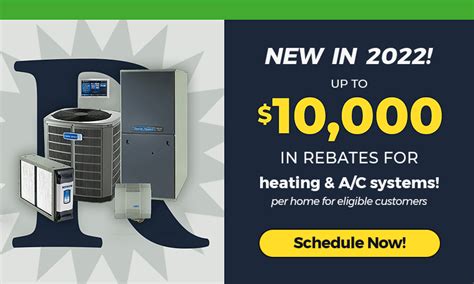When it comes to upgrading your home’s heating, ventilation, and air conditioning (HVAC) system, the initial costs can be daunting. However, there are numerous rebate programs available that can help you offset these costs. This article will guide you through how to maximize rebates on your new HVAC system, ensuring you get the most savings possible while improving your home’s comfort and energy efficiency.
Understanding HVAC Rebates
Before diving into how to maximize your savings, it’s essential to understand what HVAC rebates are. Rebates are incentives offered by manufacturers, utility companies, or government programs to encourage homeowners to purchase energy-efficient systems. These rebates can significantly reduce the overall cost of your new HVAC system.
Research Available Rebates
The first step in maximizing your HVAC rebates is to research what is available in your area. Incentives can vary from state to state and even from one utility company to another. Here’s how to find out what rebates you qualify for:
- Check with Utility Companies: Many local utility providers offer rebates for energy-efficient appliances, including HVAC systems. Visit their website or contact them directly for more details.
- Visit Government Websites: The U.S. Department of Energy and Energy Star are excellent resources for finding federal or state-sponsored rebate programs.
- Manufacturer Promotions: Many HVAC manufacturers offer their own rebate programs. Be sure to check their promotions when shopping for a new system.
Choose Energy-Efficient Systems
Opting for an energy-efficient HVAC system is crucial for maximizing rebates. Look for systems with high Seasonal Energy Efficiency Ratio (SEER) ratings, as these often qualify for additional rebates. Energy-efficient systems save you money on utility bills over time while still making you eligible for rebates. Here are some specifications to consider:
- SEER Rating: A higher SEER rating typically indicates a more efficient system.
- Energy Star Certification: Systems that have earned this label meet specific energy efficiency criteria set by the EPA (Environmental Protection Agency).
- Variable-speed Technology: Systems with variable-speed fans and compressors can operate more efficiently, leading to potential savings.
Work with a Qualified Contractor
Choosing the right contractor is a vital part of getting the most out of your HVAC rebate. A qualified contractor will have experience with energy-efficient installations and be familiar with local rebate programs. Here’s how to find one:
- Read Reviews: Check online reviews and ask for recommendations from friends or family.
- Verify Credentials: Ensure your contractor is licensed, insured, and has qualifications in energy-efficient HVAC systems.
- Get Multiple Quotes: Compare quotes from different contractors to ensure you receive a fair price and find someone knowledgeable about rebates.
Keep Documentation Organized
Once you’ve purchased your new HVAC system, keeping your documentation organized is crucial for claiming rebates. This includes receipts, warranty information, and any paperwork provided by your contractor. Many rebate programs require specific forms to be filled out, so having everything readily available will speed up the process.
Timing Your Purchase
Timing can play a significant role in maximizing your HVAC rebates. Often, manufacturers and utility companies run seasonal promotions, which can enhance your potential savings. Here are tips for timing your purchase:
- Off-Season Purchases: Consider upgrading your HVAC system during the off-season (late fall or early spring) when demand is lower. Contractors may offer better pricing and additional rebates during these times.
- End-of-Year Promotions: Many companies aim to clear out inventory at the end of the year, so keep an eye out for discounts and rebates during this period.
Apply for Rebates Promptly
Rebate forms often have strict deadlines for submission. To ensure you receive your rebate, submit all requested documentation promptly after installation. Double-check the requirements and make sure you’ve filled out the forms correctly. Any missing information could delay or even disqualify your rebate.
Follow-Up
After you’ve submitted your rebate application, don’t hesitate to follow up with the rebate provider. Keep a record of your submission, including dates and any reference numbers. This can be useful if there are any delays or issues with your application.
Conclusion
Upgrading your HVAC system doesn’t have to break the bank, especially when you leverage available rebates effectively. By researching and understanding the available programs, choosing energy-efficient systems, working with qualified contractors, and keeping your documentation organized, you can maximize your savings. Timing your purchase and promptly applying for rebates will further enhance your chances of securing substantial financial benefits. With the right approach, your new HVAC system can lead to significant long-term savings both in energy costs and rebates.
Frequently Asked Questions
1. What types of rebates are available for HVAC systems?
Rebates can come from manufacturers, local utility companies, and government programs. They often focus on energy efficiency, system upgrades, and specific qualified products.
2. How do I know if I qualify for a rebate?
Check with your local utility company, state energy office, or manufacturer promotions. Many websites offer tools to evaluate eligibility based on your energy-efficient purchases.
3. Can I apply for multiple rebates?
Yes, in many cases, you can apply for rebates from multiple sources, such as utility companies and manufacturers. Just ensure you meet the requirements set by each program.
4. How long does it take to receive a rebate?
Timeline varies by provider, but you should expect to wait anywhere from a few weeks to a few months after submission. Always check the specific terms outlined in the rebate form.
5. What happens if I miss the rebate deadline?
If you miss the deadline, you typically lose the chance to claim the rebate. Some programs might allow appeals or extensions, but it varies by provider.
This HTML code can be directly used in a WordPress block or post, where it will format the article with appropriate headings, paragraphs, and lists for readability.
Download Rebates On New Hvac Systems
